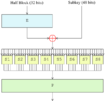Portal:Technology/Selected article/archive
March 27, 2007
Windows Vista is the latest release of Microsoft Windows, a line of graphical operating systems used on personal computers, including home and business desktops, notebook computers, Tablet PCs, and media centers. Prior to its announcement on July 22, 2005, Windows Vista was known by its codename "Longhorn".[1] Development was completed on November 8, 2006; over the following three months it was released in stages to computer hardware and software manufacturers, business customers, and retail channels. On January 30, 2007, it was released worldwide to the general public,[2] and was made available for purchase and downloading from Microsoft's web site.[3] The release of Windows Vista comes more than five years after the introduction of its predecessor, Windows XP, making it the longest time span between two releases of Windows versions. Read More
September 2006
35 mm film is the basic film gauge most commonly used for both still photography and motion pictures, and remains relatively unchanged since its introduction in 1892 by William Dickson and Thomas Edison, using film stock supplied by George Eastman. The photographic film is cut into strips 1 3/8 inches or 35 mm wide — hence the name. The standard negative pulldown is four perforations per frame along both edges, which makes for exactly 16 frames per foot.
A wide variety of largely proprietary gauges were independently invented and used around the late 19th century and early 20th century, ranging from 13 mm to 75 mm. 35 mm was eventually recognized as the international standard gauge in 1909, and has by far remained the dominant film gauge for both image origination and projection. Within the past hundred years, it has been modified to include sound, redesigned to create a safer film base, formulated to capture color, accommodated a bevy of widescreen formats, and incorporated digital audio data into nearly all of its non-frame areas. Since the beginning of the 21st century, the manufacturing of 35 mm motion picture film has been a duopoly between Eastman Kodak and Fujifilm. (read more)
June 21, 2006
The Data Encryption Standard (DES) is a cipher (a method for encrypting information) selected as an official Federal Information Processing Standard (FIPS) for the United States in 1976, and which has subsequently enjoyed widespread use internationally. The algorithm was initially controversial, with classified design elements, a relatively short key length, and suspicions about a National Security Agency (NSA) backdoor. DES consequently came under intense academic scrutiny, and motivated the modern understanding of block ciphers and their cryptanalysis. DES is now considered to be insecure for many applications. This is chiefly due to the 56-bit key size being too small; DES keys have been broken in less than 24 hours. There are also some analytical results which demonstrate theoretical weaknesses in the cipher, although they are infeasible to mount in practice. The algorithm is believed to be practically secure in the form of Triple DES, although there are theoretical attacks. In recent years, the cipher has been superseded by the Advanced Encryption Standard (AES). (read more)
- May 21, 2006

FIRST, or For Inspiration and Recognition of Science and Technology, is an organization founded by inventor Dean Kamen in 1989 in order to develop ways to excite students about engineering and technology. The first event was the FIRST Robotics Competition (FRC), which is designed to inspire high school students to become engineers by giving them real world experience working with professional engineers to develop a robot. The inaugural FIRST Robotics Competition was held in 1992. Later on, the FIRST LEGO League, a program similar to the FIRST Robotics Competition, was formed. It is aimed at younger students and it utilizes Lego Mindstorms sets to build palm-sized robots, rather than the actual person-sized metal robots that the high schoolers in the FRC build. The latest event to be added to FIRST is the FIRST Vex Challenge, started in 2005... (Read more...)
- April 14, 2006

A USB flash drive is essentially NAND-type flash memory integrated with a USB 1.1 or 2.0 interface used as a small, lightweight, removable data storage device of up to 64 GB (as of 2006[update]). USB flash drives use the USB mass storage standard for removable storage devices. To use such a device, your operating system must have driver support for both USB mass storage plus the file system used on the flash drive. All versions of Mac OS X support USB Mass Storage devices natively. Microsoft Windows XP, 2000 and ME shipped with native support for USB Mass Storage devices, but any previous Windows version requires a driver that is usually available from the manufacturer. All versions of Linux which support USB and SCSI storage support USB flash drives, although some desktop environments assume that the drive is partitioned (not a safe assumption). Some recent USB flash drives act as two drives - as a removable disk device (the actual drive itself), and as a USB floppy drive (again, as the actual drive itself, but as another drive in Windows). Normally, the drivers for the removable disk device would be located on the floppy drive (one portion of the removable disk device), for operating systems that cannot find the driver for the drive natively. (Read more...)
- March 24, 2006

A central processing unit (CPU), or sometimes simply processor, is the component in a digital computer that interprets instructions and processes data contained in software. CPUs provide the fundamental digital computer trait of programmability, and are one of the core components found in almost all modern microcomputers, along with primary storage and input/output facilities. A CPU that is manufactured using integrated circuits, often just one, is known as a microprocessor. Since the mid-1970s, single-chip microprocessors have almost totally replaced all other types of CPUs, and today the term "CPU" almost always applies to some type of microprocessor. The phrase "central processing unit" is, in general terms, a description of a certain class of logic machines that can execute complex computer programs. This broad definition can easily be applied to many early computers that existed long before the term "CPU" ever came into widespread usage. However, the term itself and its acronym have been in use in the computer industry at least since the early 1960s (Weik 1961). The form, design and implementation of CPUs have changed dramatically since the earliest examples, but their fundamental operation has remained much the same. (Read more...)
- January 27, 2006

The Deep Space Network is an international network of radio antennas that supports interplanetary spacecraft missions, and radio and radar astronomy observations for the exploration of the Solar System and the universe. The network also supports selected Earth-orbiting missions. DSN is part of the NASA Jet Propulsion Laboratory. The Deep Space Network currently consists of three deep-space communications facilities placed approximately 120 degrees apart around the world at Goldstone, California, Robledo de Chavela, Spain, and Canberra, Australia. Each facility is situated in semi-mountainous, bowl-shaped terrain to shield against radio frequency interference. This strategic placement permits constant observation of spacecraft as the Earth rotates, and helps to make the DSN the largest and most sensitive scientific telecommunications system in the world. Most recently the Deep Space Network is going to be used to send to and receive signals from the Pluto probe New Horizons. (Read more...)
- January 3, 2006

The Saturn V (popularly known as the Moon Rocket) was a multistage liquid-fuel expendable rocket most well known for its use in NASA's Apollo program. It was the largest production model of the Saturn family of rockets, although NASA contemplated larger models (such as the Nova rocket). The rocket was designed under the direction of Wernher von Braun at the Marshall Space Flight Center, with the lead contractors being The Boeing Company, North American Aviation, Douglas Aircraft Company, and IBM. Saturn V rockets were launched between 1967 and 1973. The Saturn V rocket was also used to launch Skylab. To this day the Saturn V remains the largest rocket ever launched. (Read more...)
- November 11, 2005
An industrial robot was officially defined by ISO (Standard 8373:1994, Manipulating Industrial Robots – Vocabulary) as an automatically controlled, reprogrammable, multipurpose manipulator programmable in three or more axes. The field of industrial robotics may be more practically defined as the study, design and use of robot systems for manufacturing (a top-level definition relying on the prior definition of robot). Typical applications of industrial robots include welding, painting, ironing, assembly, pick and place, palletizing, product inspection, and testing, all accomplished with high endurance, speed, and precision. Manufacturers of industrial robots include: Intelligent Actuator, Adept, Epson Robots, Yaskawa-Motoman, ABB, Epson-Seiko, IGM Robotersysteme, Comau, Cloos GmbH, KUKA Robotics, Kawasaki and FANUC Robotics. (Read more...)
- June 19, 2005

Soldering is a process of joining metal parts using a filler metal of low melting point (solder). Heat is applied to the metal parts, and the soft filler metal is pressed against the joint, melts, and is drawn into the joint by capillary action with the help of the appropriate flux material (which helps reduce oxidation of the metal parts and increases the strength of the bond). After the metal cools, the resulting joints are not as strong as the base metal, but have adequate strength, electrical conductivity, and water-tightness for many uses. Soldering is an ancient technique that has been used practically as long as humans have been making articles out of metal. (Read more...)
References[edit]
- ^ Microsoft (2005-07-22). "Media Alert: Microsoft Unveils Official Name for "Longhorn" and Sets Date for First Beta Targeted at Developers and IT Professionals". Retrieved 2007-01-02.
- ^ "Microsoft Launches Windows Vista and the 2007 Office System to Consumers". PressCentre. Microsoft New Zealand. 2007-01-30. Retrieved 2007-01-30.
- ^ "Windows Marketplace: Windows Vista Upgrade Editions: Get Started". Windows Marketplace. Microsoft. January 30, 2007. Retrieved 2007-01-30.

